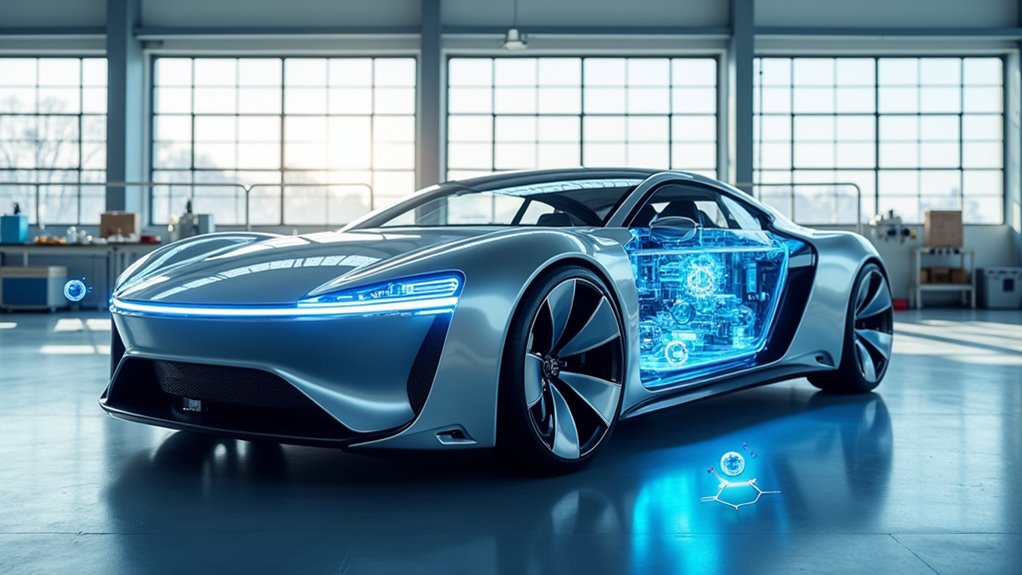Fuel cells turn hydrogen into electricity through a chemical process. Hydrogen gas reaches the anode, where a catalyst splits it into protons and electrons. Electrons flow through an external circuit to produce power, while protons move through the electrolyte to the cathode, where they combine with oxygen to form water. This clean, efficient process powers vehicles with zero emissions. Keep exploring to discover more about how this technology fuels our future.
Key Takeaways
- Fuel cells convert hydrogen into electricity through chemical reactions involving a platinum catalyst and an electrolyte membrane.
- Hydrogen at the anode splits into protons and electrons; electrons generate electrical current used to power vehicles.
- Oxygen at the cathode reacts with protons and electrons to produce water as the only emission.
- The process offers high efficiency (~60%) and rapid refueling times, making it suitable for clean transportation.
- Advantages include zero emissions, minimal maintenance, and the potential for sustainable energy when sourced from renewable hydrogen.
How Fuel Cells Convert Hydrogen Into Electricity
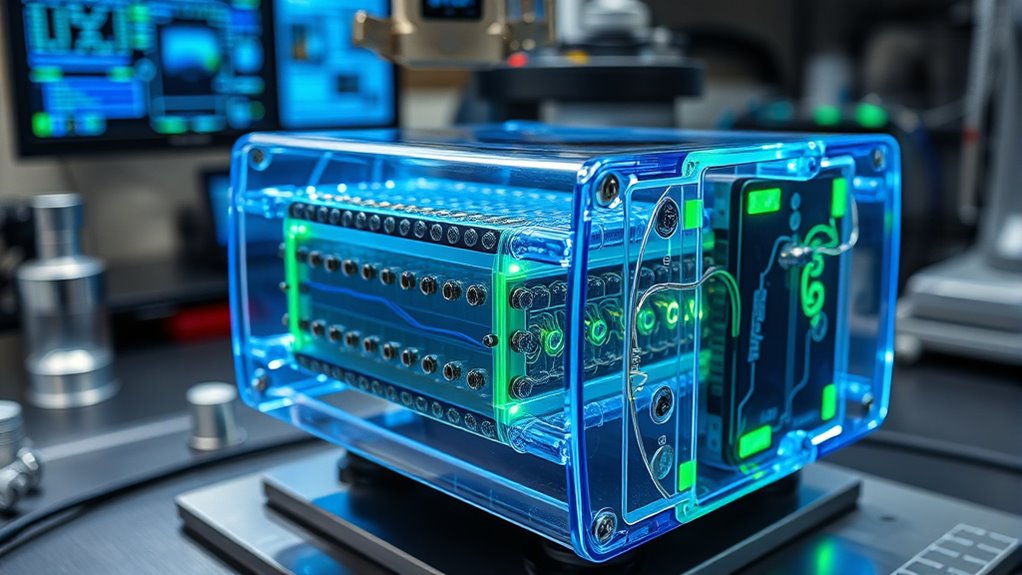
How do fuel cells turn hydrogen into electricity? When hydrogen gas reaches the anode, a catalyst—usually platinum—splits it into protons (H⁺) and electrons (e⁻). The catalyst speeds up this reaction without being consumed. The electrons are forced to travel through an external circuit, creating an electric current that powers your devices or motor. Meanwhile, the protons pass through an electrolyte membrane toward the cathode, maintaining charge balance. This separation of electrons and protons allows energy to be harnessed efficiently without combustion. As the electrons move through the circuit, they generate usable electricity. The process is clean, efficient, and continuous as long as hydrogen and oxygen are supplied. This conversion forms the core of how fuel cells produce electricity from hydrogen fuel. The electrolyte permits only specific ions to pass, ensuring the chemical process remains uninterrupted. Additionally, ongoing research aims to develop robust safety measures to address potential vulnerabilities in AI systems supporting fuel cell technology.
The Chemical Reactions Inside a Fuel Cell
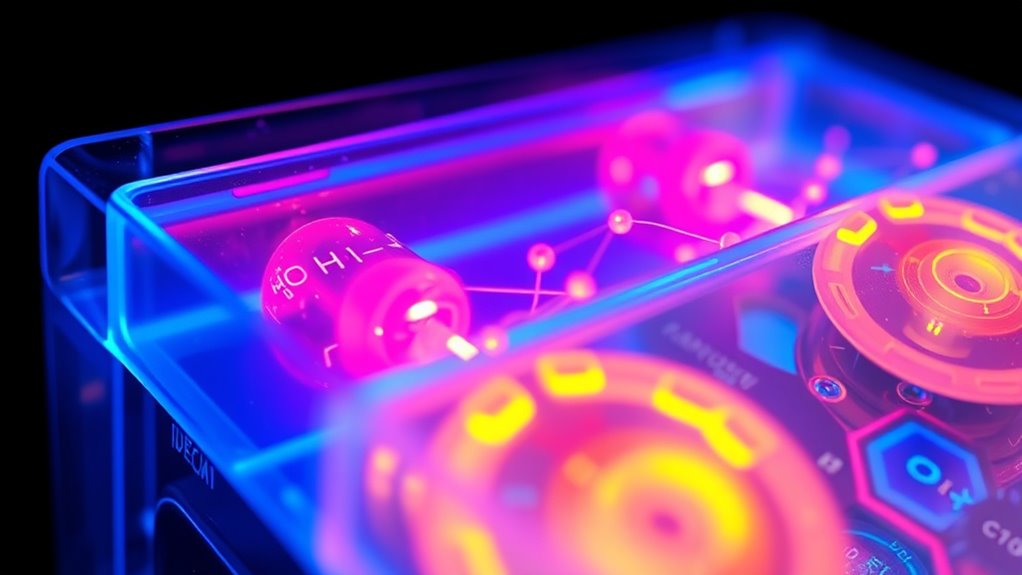
Inside a fuel cell, chemical reactions occur at the electrodes that convert hydrogen and oxygen into electricity and water. At the anode, hydrogen gas splits into protons and electrons, with platinum speeding up this oxidation: (2H_2 rightarrow 4H^+ + 4e^-). The electrons flow through an external circuit, creating electrical power. Vetted – Mother Baby Kids Meanwhile, protons pass through the electrolyte to the cathode. There, oxygen molecules gain electrons and react with protons to form water: (O_2 + 4H^+ + 4e^- rightarrow 2H_2O). This process releases heat and produces water as a byproduct. Different fuel cell types may involve other ions, like carbonate or oxide ions, depending on the electrolyte used. Overall, these reactions efficiently convert chemical energy into electrical energy, powering clean vehicles.
Advantages of Fuel Cell Technology for Vehicles
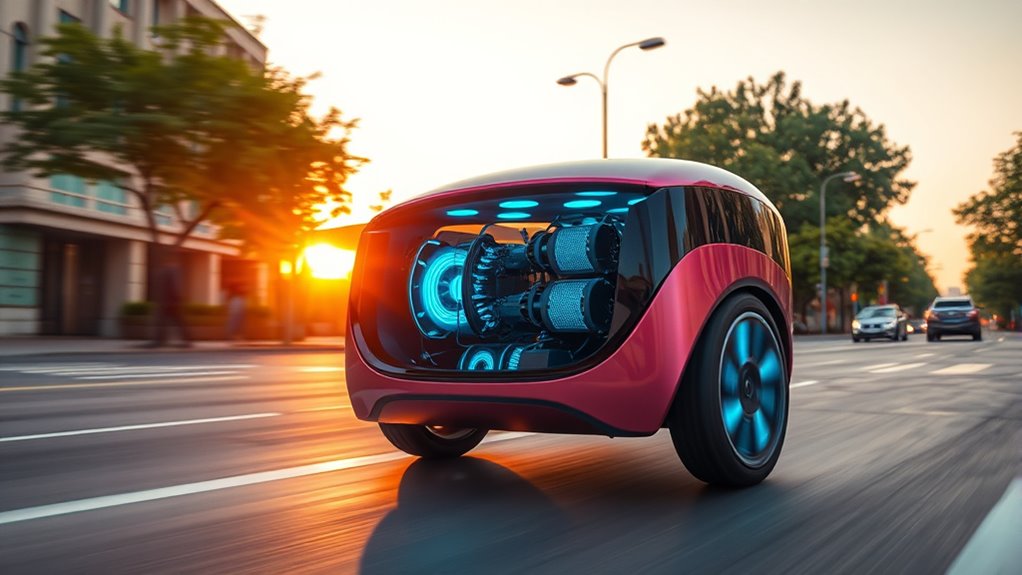
Fuel cell technology offers significant advantages for vehicles, making them a promising alternative to traditional combustion engines. You’ll notice higher efficiency, with hydrogen fuel cells reaching around 60%, compared to just 25% for internal combustion engines. They deliver instant torque and smooth power, improving driving performance. Hydrogen fuel cells produce no harmful emissions, with only heat and water as by-products when fueled with pure hydrogen. Hydrogen fuel cell vehicles can travel about 500 km on a full tank, matching gasoline cars. Refueling is quick, taking only three to five minutes, and the systems are designed for long-lasting performance, even in cold weather. Maintenance needs are minimal, saving you time and money. Plus, many regions offer incentives like access to carpool lanes. Overall, fuel cell vehicles combine efficiency, convenience, and technology to provide a compelling, eco-friendly transportation option.
Environmental Benefits of Hydrogen-Powered Cars
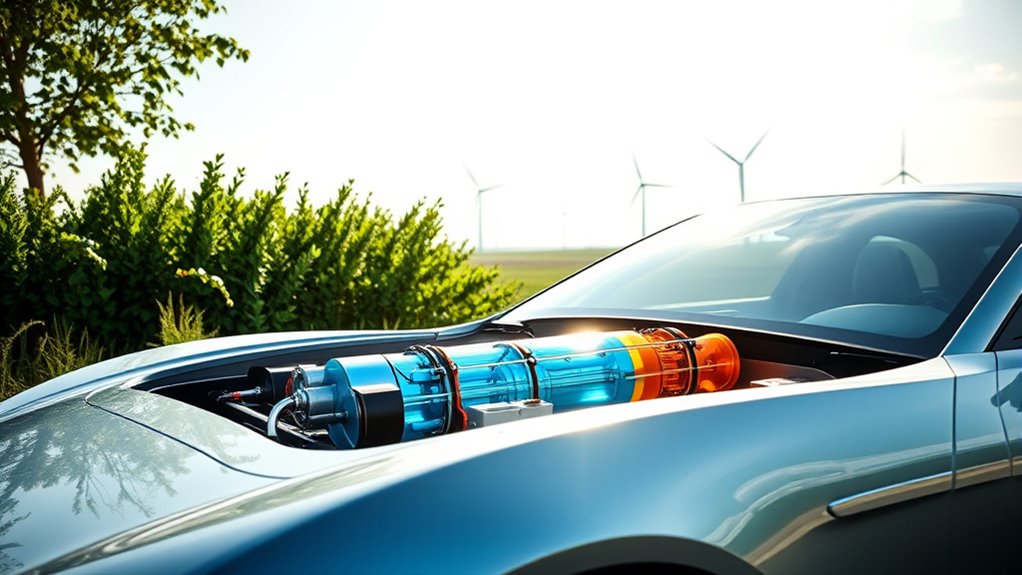
Hydrogen-powered cars offer a remarkable environmental advantage by producing only water and warm air as emissions, making them a true zero-emission alternative to conventional vehicles. By not releasing pollutants like nitrogen oxides, hydrocarbons, or particulate matter, they substantially improve air quality and reduce urban pollution.
When hydrogen is produced from renewable sources such as solar or wind, it minimizes greenhouse gas emissions throughout its lifecycle. This shift helps lower the overall carbon footprint of transportation.
Reduced emissions also mean healthier communities, especially in areas with high pollution levels, leading to fewer respiratory and cardiovascular issues.
Additionally, hydrogen fuel cells operate more efficiently than traditional engines, further decreasing energy waste and supporting sustainable, cleaner transportation solutions for the future.
Practical Considerations for Fuel Cell Vehicles

Practical considerations play a crucial role in the adoption and effectiveness of fuel cell vehicles. One key factor is their range, which is comparable to traditional cars at about 300 miles, making them suitable for long-distance travel. They excel in heavy-duty applications like trucking and public transit due to their power and efficiency. Unlike some electric vehicles, fuel cell cars perform well in cold weather, maintaining consistent performance. Refueling is quick, taking just a few minutes, similar to gasoline vehicles, which minimizes downtime. Additionally, AI security technologies can enhance safety protocols for hydrogen infrastructure and vehicle systems by detecting anomalies and preventing cyber threats. However, infrastructure remains a challenge; hydrogen stations are limited, expensive to build, and require strict safety measures. Hydrogen’s flammability is a safety concern that must be carefully managed through rigorous protocols. Overcoming these logistical hurdles is essential for wider adoption, ensuring fuel cell vehicles can deliver their full potential in daily use.
Overcoming Challenges in Fuel Cell Adoption
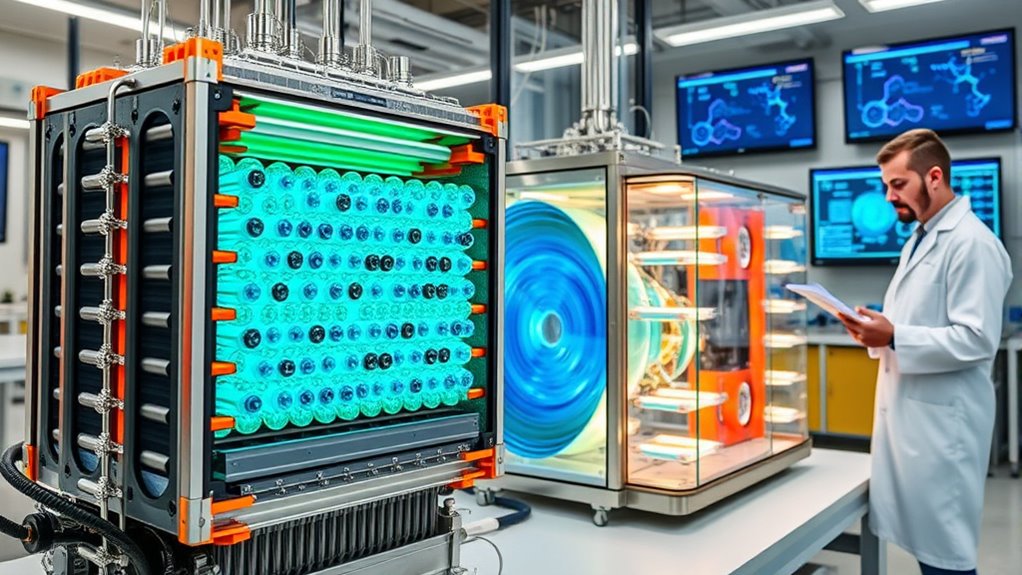
What are the biggest hurdles standing in the way of widespread fuel cell vehicle adoption? The main challenges include limited infrastructure, high costs, and technological gaps. Building a hydrogen fueling network requires substantial investment and government support, yet current stations can only serve about 30 cars daily. The high cost of hydrogen production and vehicle prices slows adoption, and economies of scale are needed to lower these costs. Technological issues, like improving fuel cell durability and integrating systems, also pose barriers. Additionally, maintaining a reliable hydrogen supply and boosting public awareness are essential. To help you understand, here’s a quick overview:
| Challenge | Impact | Solution Focus |
|---|---|---|
| Infrastructure | Limited fueling stations | Investment and government support |
| Cost | Expensive hydrogen and vehicles | Scale production, subsidies |
| Technology | Compatibility and durability issues | Innovation and R&D |
| Supply & Reliability | Supply chain disruptions | Developing transport/storage |
| Public Awareness | Low acceptance and understanding | Education campaigns |
A robust hydrogen supply chain is also crucial for supporting widespread adoption and ensuring consistent fuel availability.
Frequently Asked Questions
How Long Do Fuel Cell Vehicles Typically Last Before Major Repairs?
You’re wondering how long fuel cell vehicles last before major repairs. Typically, their fuel cell stacks are designed to last around 150,000 to 200,000 miles or about 5,000 hours of operation.
Heavy-duty vehicles like buses can exceed 20,000 hours. With proper maintenance, most fuel cell stacks only need repairs near the end of their lifespan, making major repairs rare within the vehicle’s expected durability period.
What Are the Safety Measures for Storing High-Pressure Hydrogen Onboard?
Remember, safety first is safety always. When storing high-pressure hydrogen onboard, you’ll want to keep cylinders in outdoor or well-ventilated areas, away from heat sources or oxidants.
Use secure, noncombustible enclosures and weld piping for transfer.
Install hydrogen sensors, emergency ventilation, and automatic shutoff systems.
Regular inspections, proper separation distances, and personnel training are essential.
These measures help prevent leaks, control hazards, and keep everyone safe in case of an emergency.
Can Hydrogen Be Produced Sustainably at Scale for Vehicle Use?
You’re asking if hydrogen can be produced sustainably at scale for vehicles. The good news is, yes, it’s possible.
Technologies like electrolysis powered by renewable energy—solar, wind, or hydro—are advancing rapidly, making green hydrogen more affordable and widespread.
Challenges remain, like scaling up infrastructure and reducing costs, but with continued policy support and innovation, sustainable hydrogen for vehicle use can become a reality soon.
How Does Refueling Infrastructure Compare to Electric Charging Stations?
When comparing refueling infrastructure to electric charging stations, you’ll find that EV stations are more widespread, especially in cities.
However, they often require costly grid upgrades and longer charging times.
Hydrogen refueling stations are limited but offer quick refueling, similar to gasoline.
For rural areas, hydrogen stations are more accessible since they don’t depend heavily on grid capacity.
Are There Ongoing Innovations to Reduce Fuel Cell Costs Significantly?
You’re asking if ongoing innovations are helping to cut fuel cell costs substantially. The answer is yes. Researchers are developing new manufacturing techniques inspired by computer chip production, which reduce expensive materials like platinum.
Companies are also streamlining production processes with automation and high-speed methods, lowering labor costs. Innovations like ACAL Energy’s FlowCathTM technology further cut platinum use by 80%, making fuel cells more affordable and boosting their commercial viability.
Conclusion
As you explore fuel cell technology, remember that it’s like having a modern chariot powered by hydrogen’s promise, leaving behind the smog of old. While challenges remain—much like steering uncharted waters—you’re on the cusp of a cleaner, greener future. Embrace this journey today, for the chemistry powering these cars is truly revolutionary, promising a world where air stays fresh and the skies stay blue, just like in the days of a brighter tomorrow.
